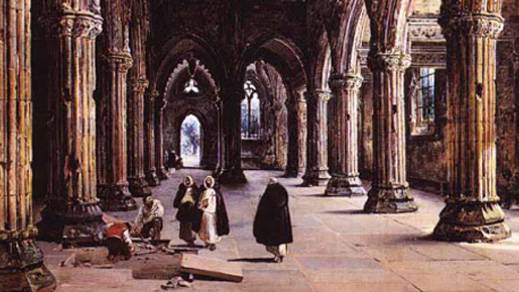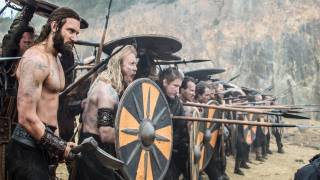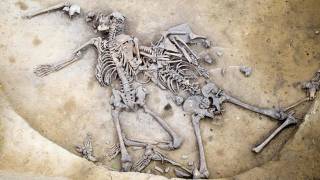The Rosslyn Bones
Source: atlantisrisingmagazine.com
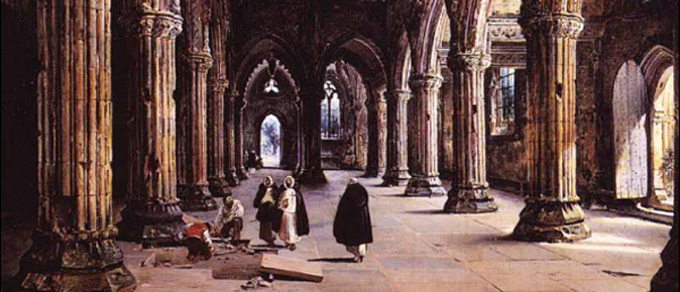
Is the Tale of the Murdered Apprentice More Than Just a Legend?
Photographic pioneer and artist Louis Daguerre’s 1824 painting, The Interior of Rosslyn Chapel, shows two workmen crouching by the base of a pillar, with three Templar Knights nearby. One workman is staring intently at some bones they have found beneath the flagstones.
For a bizarre example of life imitating art, let’s fast-forward 186 years.
On March 1, 2010, Scottish Television reported that workmen at Rosslyn, the chapel made famous by The Da Vinci Code, had discovered remains in an area with no recorded burials. The remains, continued the STV report, had been “removed from the site to be examined by archaeologists to discover their age, type and if they are human or animal.”
The local police confirmed the find but said “it was not being treated as a crime.” Rosslyn Chapel declined comment.
Two things aroused my interest.
First, I was sure that even an untrained eye would be able to distinguish between animal and human remains and wondered why the archaeologists could not do the same. Second, I wondered exactly where the remains had been discovered. The idea they might have been found in the spot Daguerre showed in his painting made me chuckle.
It would take me a year to get some answers.
During that time, I searched for news updates. There were none. I also broached the subject with two St. Clair/ Sinclair clan online forums. Since a William St. Clair had built the chapel in the mid-fifteenth century, these groups share an abiding interest in its history. No one knew anything.
Finally, on Feb. 21, I wrote to a Rosslyn Chapel executive. There was no reply.
Someone knew more, but no one was talking.
Two weeks later, however, my inquiries finally bore some fruit—an Email containing four remarkable photos of the excavation, before the remains had been moved.
One showed leg bones that were undoubtedly human, confirming that one of the stated reasons for their removal was, as I suspected, clearly bogus.
Two showed the exact location of the remains, but it was not the area shown in Daguerre’s painting. Instead, they had been found at the threshold of the west door.
The fourth showed a skull, face down, with a ragged-looking wound just a short distance above the foramen magnum, the natural aperture that allows the spinal cord to connect with the brain.
Taking just a small leap of the imagination, what might this tell us?
There’s a long-lived legend that Rosslyn’s master mason, returning from Rome after studying the design of an exquisite pillar in person, found an apprentice had carved the pillar in his absence. Flying into a rage, he slew the apprentice with a blow to the head, a legend that resonates with the eponymous murder of Hiram Abiff, chief architect of Solomon’s Temple, absolutely central to the Freemasonic ritual of the Third Degree.
Could the skull belong to the apprentice? The teeth were in remarkably youthful condition, and the shape of the head wound appeared consistent with the stone-trimming end of a mason’s hammer.
Researchers skeptical of the chapel’s claimed Masonic roots scoff at the legend, protesting that it’s not exclusive to Rosslyn. While there are indeed similar tales told about other ecclesiastical buildings of the day, I’m not so quick to throw the baby out with the bathwater. As a speculative researcher, and in the absence of the forensic evidence already more than a year in coming, I’m happy to present some speculative thoughts about the Rosslyn bones.
Above the area of discovery are three carved heads. Rosslyn tradition describes the one in the southwest, gazing northeast, as the head of the apprentice; the one in the northwest, gazing southeast, as the head of the master mason; and, on an adjacent wall, the apprentice’s mother, weeping for her son. The chapel’s website describes the master’s gaze as his punishment, forever condemned to look southeast towards the now-famous Apprentice Pillar. Not much of a punishment for murder, certainly.
I have since received, however, another dispatch that suggests a stiffer sentence: There were two skeletons found at Rosslyn, in a single grave. Could one be the master?
That they were found at the threshold of the chapel conjures up a plump scenario of darkly poetic justice.
History records many examples of human remains being buried in the foundations of buildings, and at their thresholds, but the reasons are varied. Legend has it that Saint Dunstan ordered his own burial to be under the threshold of Winchester Cathedral as a testament to his humility; Scotland’s St. Columba, by contrast, is said to have buried a man alive at the foundations of a cathedral in order to ensure the building’s structural stability with blood sacrifice; and I will give a third example, later on, where the practice was meant as an insult to the deceased.
Another robust legend that may connect Rosslyn with threshold sacrifice is the widespread belief that the chapel’s ground plan is based on that of Solomon’s Temple, although skeptics point out that Rosslyn’s is identical to that of Glasgow Cathedral, which, except for the enormous difference in scale, is true.
But what if the similarities between Rosslyn and Solomon’s Temple, at least for Freemasons, were meant to be more symbolic than actual and that both skeptics and true believers have been looking at things the wrong way?
In Albert Mackey’s Encyclopedia of Freemasonry is the following entry: “Over the Sacred Lodge presided Solomon, the greatest of kings, and the wisest of men; Hiram, the great and learned King of Tyre; and Hiram Abiff, the widow’s son, of the tribe of Naphtali. It was held in the bowels of the sacred Mount Moriah, under the part whereon was erected the Holy of Holies. On this mount was where Abraham confirmed his faith by his readiness to offer up his only son, Isaac. Here it was where David offered that acceptable sacrifice on the threshing-floor of Araunah by which the anger of the Lord was appeased, and the plague stayed from his people. Here it was where the Lord delivered to David, in a dream, the plan of the glorious Temple, afterward erected by our noble Grand Master, King Solomon. And lastly, here it was where he declared he would establish his sacred name and word, which should never pass away—and for these reasons this was justly styled the Sacred Lodge.”
Might not the floor of Rosslyn Chapel be symbolic, then, of a place that predates Solomon’s Temple—the threshing floor of Araunah and a place of great Biblical sacrifice, which in many ways it still is? Claimed as a holy place by Christians, Jews, and Muslims, the rock over which now stands Jerusalem’s Dome of the Rock has become, over millennia, a most costly piece of real estate.
Also revered as “The Foundation Stone,” the rock from which the world was made, it was the place where Biblical patriarch Jacob is said to have dreamt of a ladder reaching to Heaven, with angels ascending and descending—which brings us to Scotland’s unique connection with the place. Whether or not the block of stone now safely enshrined in Edinburgh Castle is Scotland’s fabled Stone of Destiny, one of its popular monikers is “Jacob’s Pillow.” And then there is the theory that the Scots are, in fact, a “lost tribe of Israel.” When historians, Biblical scholars, and adherents to British Israelism debate that theory, things get noisy.
But let’s return to the Rosslyn bones, continuing to suppose that the remains belong to the jealous master and the slain apprentice. What better place for the apprentice to be buried than beneath the carved head of his grieving mother? And what greater insult to the master than to be condemned, forever, to be trod underfoot by God-fearing Scots?
As it happens, though, the head of the apprentice is also gazing at an exquisitely carved pillar—one attributed to the master’s hands. Curiously, there is evidence that the Master’s Pillar, as it is now known, had been concealed under a plain exterior for over 400 years and had been rediscovered by architect David Bryce during his 1860’s restoration efforts. Might it not have been concealed because it was, after all, the work of an arch sinner? The Scots have historically done much more about a lot less, particularly over matters of morality.
Whether or not there is any truth to the slain apprentice legend, it is the height of coincidence that Rosslyn’s most enduring legend involves the murder of one man by another, by a blow to the head, and that the murder has been memorialized by the carved heads of the murderer and the victim, on the wall above the unmarked grave of two recently discovered bodies, one of which shows indications of having been killed by a blow to the head.
But until the forensic experts release their findings, we must consider the possibility that the bones were put there more recently.
In 1846, during a lecture at London’s Institute of British Architects, antiquary John Britton criticized the lines in Walter Scott’s Lay of the Last Minstrel that suggest ten Rosslyn barons were buried, in full armor, below the chapel. Also in attendance was William Burn, architect in charge of the chapel’s 1830’s restoration. Burn supported Britton by claiming he had dug trenches up all three of the chapel’s aisles, finding only one vault with a wooden coffin (presumably the vault long known to be accessed under flagstones in the north aisle, towards the rear of the chapel).
Burn makes no mention of having found human remains in the center aisle. But since his work was mainly concerned with the exterior of the chapel, there remains the possibility that Burn lied to support Britton’s skeptical opinions, because the restoration of the chapel was the subject of a heated and ongoing debate. Thirty-four years later, in 1880, architect Andrew Kerr, under the direction of Robert St. Clair-Erskine, the 4th Earl of Rosslyn, added the baptistery to the chapel’s west end. If, as I suspect, the recently discovered bones stretched beneath the common threshold of both buildings, then there remains the interesting possibility that the bones were deposited there at that time, to be conveniently “discovered” at a later date. Kerr and the Earl have a well-documented conversation about the Slain Apprentice legend that appears on page 6 of the official Rosslyn Chapel guidebook, and it should be noted that both men were high-ranking Scottish Freemasons. The Earl, in fact, was the fraternity’s 63rd Grand Master.
While this article has been hampered by the lack of more available evidence, further revelations may soon be made public.
At the time of this writing, I have learned that Ashley Cowie, “resident historian” for STV’s The Hour Show, was recently seen at the chapel, shooting a new documentary series titled Legend Quest. Airing in July, the show is described as “an action-adventure series that follows real-life symbologist Ashley Cowie as he travels the world in search of hidden, mystical artifacts. Each episode is designed to combine Indiana Jones-style adventure and Da Vinci Code-type connections as theories are explored.” While that description hints the show will do for archaeology what The Deadliest Warrior has done for the history of military warfare, perhaps Cowie will surprise us. Stranger things, as we will now see, have happened.
Late in my research for this article, I stumbled upon a curious tale connecting the 4th Earl of Rosslyn with yet a third skeleton. This one, though, was the property of his widow.
On March 15, 2002, Sotheby’s auctioned the contents of Ken Paul’s London theatrical-prop company. One paragraph of the Sotheby announcement reads as follows: “The ultimate conversation piece has to be the mystery clock in a full-sized inlaid mahogany coffin, dated c. 1900—complete with real skeleton—used in the opening scenes of The Rocky Horror Picture Show. The skeleton is rumoured to be the remains of the young Italian lover and secretary of the Countess of Rosslyn. After his death she couldn’t bear to be separated from him, so she immortalized him in the clock and took him everywhere with her!” Acquired by Ken Paul from an unnamed music-hall escape artist, the clock was won by an anonymous bidder for £35,000.
The Countess of Rosslyn at the time of the skeleton clock’s manufacture had been married to the 4th Earl from 1866 until his death in 1890. Her own death, in 1933, would have provided the perfect opportunity for the rest of the family to offload Grandma’s Italian paramour to the escapologist—at an eminently negotiable price, I’m sure.
Interestingly, besides appearing in The Rocky Horror Picture Show, the clock had most recently been hired to appear in a then-unreleased film about Jack the Ripper, From Hell, which presented the theory that Jack was a Freemason.
But the story of the clock’s connection to the Countess of Rosslyn seemed suspect. I knew of only one Scottish luminary who was intimately involved with an Italian secretary—none other than Mary, Queen of Scots. On March 9, 1566, secretary David Rizzio was stabbed to death in Holyrood Palace for being the queen’s confidant and lover and for being a Catholic. It has also been bandied about that he was the father of Mary’s son, the future king of both Scotland and England.
Although a plaque in Edinburgh’s Canongate Kirkyard reads “Tradition says that this is the grave of David Rizzio,” who really knows? Could the countess and the queen have traded places in the telling of the tale over the years? Might not the bones in the clock be the bones of David Rizzio? Moreover, in a macabre concordance with the Rosslyn bones, there is an Edinburgh tradition that Rizzio’s body was first buried at the threshold of Holyrood Abbey as a sign of disrespect.
My speculation that the clock’s skeleton is David Rizzio’s is not that outrageous.
It is well known that the Freemasons have made ritualistic use of skeletal remains. One short sentence in the 1896 minutes of Edinburgh’s Mary’s Chapel Lodge reads that “Brother Hay’s presentation of a skull was accepted with thanks,” and in the 1851 minutes we find an even more bizarre entry: “The Lodge was upon this occasion presented with two Thigh Bones of a Nun by Dr. McCowan.”
The mind boggles …
Just two years later, in 1853, the 4th Earl of Rosslyn is listed as Deputy Master of the Canongate Killwinning Lodge, still located on Edinburgh’s St. John Street, just a hundred yards or so from Rizzio’s Canongate Kirk grave. That’s 1,750 miles closer than Prescott Bush, President George W’s grandfather, trekked to bring the skull of Geronimo back to Yale University’s most storied secret society, Skull & Bones.
Or could the escapologist have made the whole tale up?
Until the unnamed buyer steps forward and allows the bones to be studied, we can only speculate about the skeleton clock.
Tick, tock …
Jeff Nisbet dedicates this article to his father, Bill, who passed away before it was finished.
Original article with more images: scribd.com.com
Louis Daguerre, "Interior of Rosslyn Chapel"
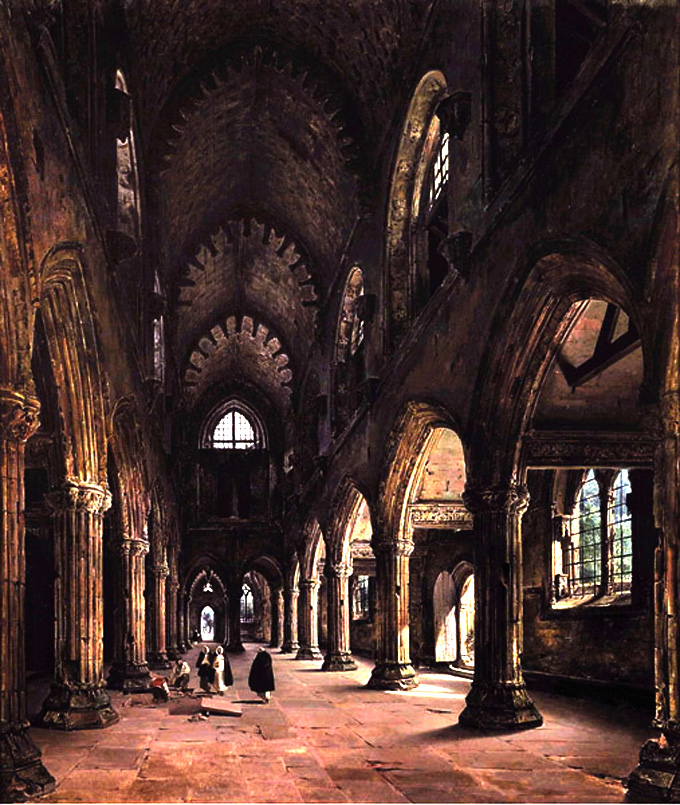
Daguerre’s contribution to the invention of photography almost entirely eclipsed his activity as a painter. This masterpiece dating from 1824 is one of the few works which have survived. This architectural view with its brilliant chiaroscuro effects is contemporary with a large-scale version, without figures, presented the same year in Paris within the framework of the Diorama sound and light shows on the Rue Samson (where Daguerre developed his photographic process a few years later).
Daguerre co-founded the Diorama with Charles-Marie Bouton, and it became extraordinarily popular. He exhibited smaller-scale versions of the great compositions presented there at several Salons: notably the Ruins of Holyrood Chapel by Moonlight, which resembles another Diorama scene (also exhibited in 1824) now in the Walker Art Gallery in Liverpool. Despite their titles in the Salon brochures, these smaller-scale versions, which were sometimes painted after the large canvases, should generally be considered as variations on the themes which made these shows so popular, rather than as preparatory works.
Rosslyn Chapel is one of Scotland’s legendary medieval sites. The picturesque qualities of this fabulous monument made it very famous during the Romantic Period. Walter Scott referred to it in The Lay of the Last Minstrel (1805), and a watercolour by John Adam Houston represents the writer sitting in the chapel. Many British watercolourists, notably John Michael Gandy, David Roberts and John Ruskin, painted views of the interior of the monument between the 1820s and the middle of the century.
After its presentation in Paris, the Diorama of Rosslyn Chapel was exhibited in London, Dublin, Liverpool and Edinburgh between 1826 and 1835. It was a huge success, as we know from articles in the press of the period. Bagpipes were played during the show, and shadowy effects were used to heighten the illusion.
Image from: musees-haute-normandie.fr
